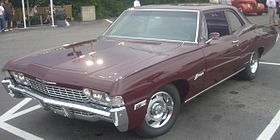Chevrolet Biscayne
| Chevrolet Biscayne | |
|---|---|

1958 Chevrolet Biscayne 4-door sedan
Former Irish government State Car, RHD |
|
| Overview | |
| Manufacturer | Chevrolet (General Motors) |
| Production | 1958–1972 (U.S.) |
| Body and chassis | |
| Class | Full-size |
| Layout | FR layout |
| Platform | GM B platform |
| Related | |
| Chronology | |
| Predecessor | Chevrolet 210 |
| First generation | |
|---|---|

1959 Chevrolet Biscayne 4-door sedan
|
|
| Overview | |
| Model years | 1958–1960 |
| Assembly |
Arlington, Texas, United States South Gate, California Oshawa, Ontario, Canada Woodville, Australia (1958 model) |
| Body and chassis | |
| Body style | 2/4-door sedan |
| Powertrain | |
| Engine | 235.5 cu in (3.9 L) Blue Flame I6 283 cu in (4.6 L) V8 348 cu in (5.7 L) V8 |
| Transmission | 3-speed manual 4-speed manual 2-speed Powerglide automatic |
| Dimensions | |
| Wheelbase | 117.5" (1958) 119" (1959–1960) |
| Length | 209.1" (1958) 210.9" (1959) |
| Width | 77.7" (1958) 79.6" (1959) |
| Second generation | |
|---|---|

1963 Chevrolet Biscayne 2-door sedan
|
|
| Overview | |
| Model years | 1961–1964 |
| Assembly |
Arlington, Texas, United States South Gate, California Oshawa, Ontario, Canada |
| Body and chassis | |
| Body style | 2/4-door sedan 5-door station wagon (1962–64) |
| Powertrain | |
| Engine |
|
| Transmission | 3/4-speed manual 3-speed Powerglide automatic |
| Third generation | |
|---|---|

1968 Chevrolet Biscayne 2 Door Sedan
|
|
| Overview | |
| Model years | 1965–1970 |
| Assembly |
Arlington, Texas, United States South Gate, California Oshawa, Ontario, Canada |
| Body and chassis | |
| Body style | 2-door sedan (1965–69) 4-door sedan 5-door station wagon |
| Powertrain | |
| Engine |
230 cu in (3.8 L) I6 (1965–66) |
| Transmission | 3/4-speed manual Powerglide auto 3-speed Turbo Hydramatic automatic |
| Fourth generation | |
|---|---|
| Overview | |
| Model years | 1971–1972 (U.S.) 1971-1975 (Canada) |
| Assembly |
Arlington, Texas, United States South Gate, California Oshawa, Ontario, Canada |
| Body and chassis | |
| Body style |
|
| Platform | B-body |
| Powertrain | |
| Engine | 350 cu in (5.7 L) V8 400 cu in (6.6 L) V8 454 cu in (7.4 L) V8 250 cu in (4.1 L) I6 |
| Transmission | 3-speed manual (standard, 1971–1973 on all six-cylinder cars) 3-speed Turbo-Hydramatic automatic (optional 1971–1973 on six-cylinder cars; standard on V-8 powered cars from mid-1971 onwards) |
The Chevrolet Biscayne was a series of automobiles produced by the American manufacturer Chevrolet between 1958 and 1972. Named after a show car displayed at the 1955 General Motors Motorama, the Biscayne was the least expensive model in the Chevrolet full-size car range (except the 1958-only Chevrolet Delray). The absence of most exterior and fancy interior trimmings remained through the life of the series, as the slightly costlier Chevrolet Bel Air offered more interior and exterior features at a price significantly lower than the mid-line Chevrolet Impala.
Biscaynes were produced primarily for the fleet market, though they were also available to the general public — particularly to those who wanted low-cost, no-frills transportation with the convenience, room and power of a full-size automobile. While most Biscaynes were sold with a six-cylinder engine through the late 1960s, the V8 engine became the more popular powerplant by the early 1970s.1. The Biscayne was usually built as a two- or four-door sedan, although a four-door station wagon was available between 1962 and 1968 (and again after 1973 in Canada only). A low-priced, full-size Biscayne station wagon equivalent was available as the Chevrolet Brookwood both before and after this period. The two-door sedan was dropped after 1969, and consequently from 1970 to 1972 the only Biscayne model available was a four-door sedan. In 1958, the Delray was priced below the Biscayne, but was discontinued the following year.
Many of the luxury convenience options available on the more expensive full-sized Chevrolet models, such as power windows, were not available on the Biscayne. However, customers could purchase a Biscayne with any of Chevrolet's high-output big-block V8 engines and performance-oriented transmissions, including the floor-mounted four-speed manual transmission with Hurst shifter and low-ratio final drive. Original production numbers of cars built this way were very low, and examples of these high-performance cars are highly sought after by collectors today. Notably, Baldwin Chevrolet of Long Island, New York, became famous for offering the "Street Racer Special," a 1968 Biscayne coupe with dealer-fitted high-performance 427 cubic-inch V8, and heavy-duty suspension components, turning the Biscayne into a serious drag car. Biscaynes with high-performance equipment were often nicknamed "Bisquick" by enthusiasts.
...
Wikipedia
